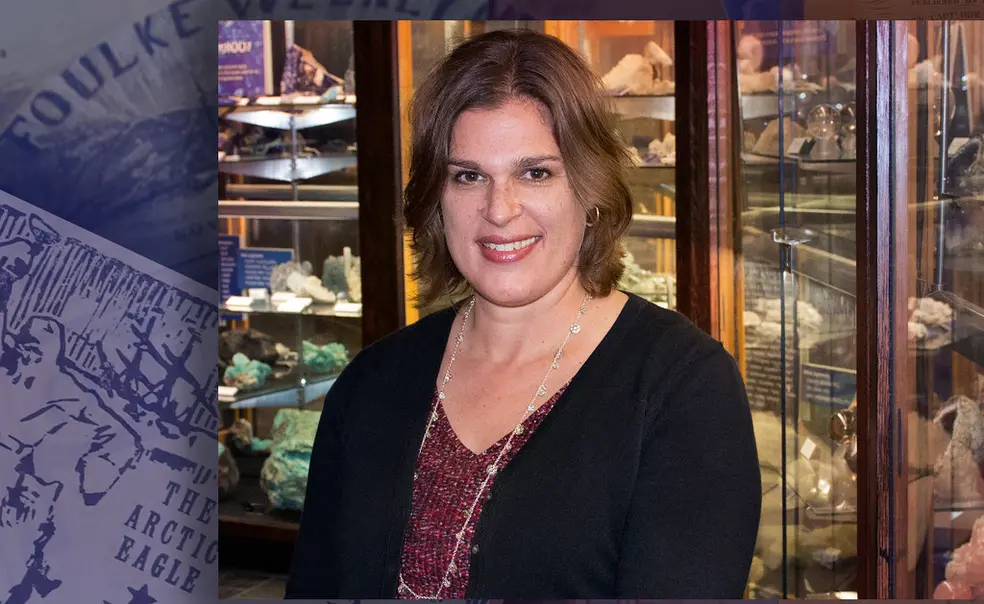Hester Blum ’95 Reports on Reporters From the Ends of the Earth

The book: The News at the Ends of Earth: The Print Culture of Polar Expeditions (Duke University Press) is a history of the varied publications printed about polar expeditions during the 19th century, from newsletters to playbills to messages in bottles. Hester Blum ’95 examines the production, circulation, and collection of these media created by explorers during long months spent in the frigid Arctic and Antarctic.
Blum examines the advice and warnings crew members passed on to future expeditions to help them survive in the polar extremities, and she takes this shared knowledge into the 21st century. As today’s climatic environment becomes increasingly extreme, she believes we could learn something from the environmental writings of the polar expeditions of the 1800s.
The author: Hester Blum ’95 is an associate professor of English at Pennsylvania State University, author of The View from the Masthead: Maritime Imagination and Antebellum American Sea Narratives, and editor of Turns of Events: Nineteenth-Century American Literary Studies in Motion and Horrors of Slaver: Or, The American Tars in Tripoli.
Opening lines: Polar exploration produces writing. Whether form the Northwest Passage—seeking Arctic voyages of the early nineteenth century or the “heroic age” of Antarctic ventures in the early twentieth, the most consistent outcomes of historic polar missions were not expeditionary feats but narrative accounts of the voyages. Expeditions were not particularly successful if judged by the standard of whether or not they fulfilled their voyage objectives; nearly all historical British and American polar missions can be said to have failed if our evaluative criteria are whether parties navigated the Northwest Passage, flagged the North or South Poles, or traversed Antarctica. As a geologist who participated in two Antarctic expeditions (and who contributed to both expeditions’ winter quarters publications, Aurora Australis and Adélie Mail and Cape Adare Times) characterized it, the four phases of polar exploration history are “(a) The voyage south from civilisation. (b) Winter and summer at winter quarters. (c) Spring and summer sledging. (d) The catastrophic phase. (May or may not occur).” Loss and death thinned many voyages, which were salvaged in the public imagination by tales of valor or endurance. Expeditionary writing told these stories. In 1880 an American naval officer and North Polar explorer, George de Long, entered in his journal, “I frequently think that instead of recording the idle words that express our progress from day to day I might better keep these pages unwritten, leaving a blank properly to represent the utter blank of this Arctic expedition.” Yet continue to write he did. And even after his ship Jeannette was annihilated by the ice and twenty of the thirty-three men aboard had perished—De Long himself among the dead—his journals remained in circulation. What do the narratives of polar exploration tell us? In large part, stories of extremity. In their meteorological, geographical, and political remove from the usual variances among nation-states or global precincts, the polar regions have been figured as impossibly remote. Today rapidly accelerating anthropogenic climate change (the evidence for which has been particularly stark in the Arctic, and increasingly in Antarctica as well) has rendered the atmospheric state of the planet itself extreme. As a result, human futurity too is in a state of extremity. Among proliferating challenges, our Anthropocenic moment has produced a crisis in how scholars think and write about humans, the nonhuman world, and the earth itself, in imaging both our present and across time.
Reviews: “What Hester Blum describes here is the production of print culture for the sake of not going crazy, for the sake of remaining, in some recognizable and accountable sense, human. This is media production under extreme duress, which makes for a fascinating story and thoughtful provocation. Founded on a thought-provoking and unique archive and bustling with insight, The News at the Ends of the Earth is a terrific book.”—Stephanie LeMenager, author of Living Oil: Petroleum Culture in the American Century












No responses yet